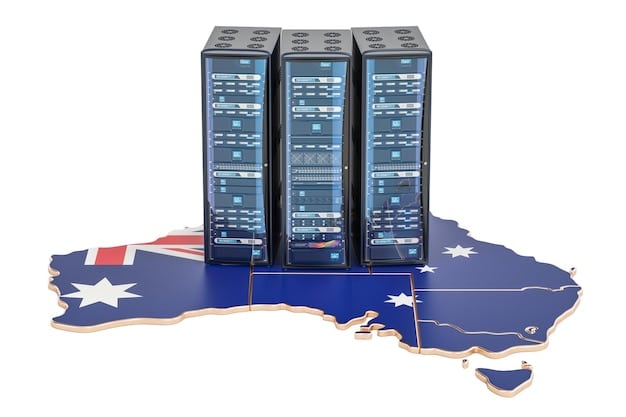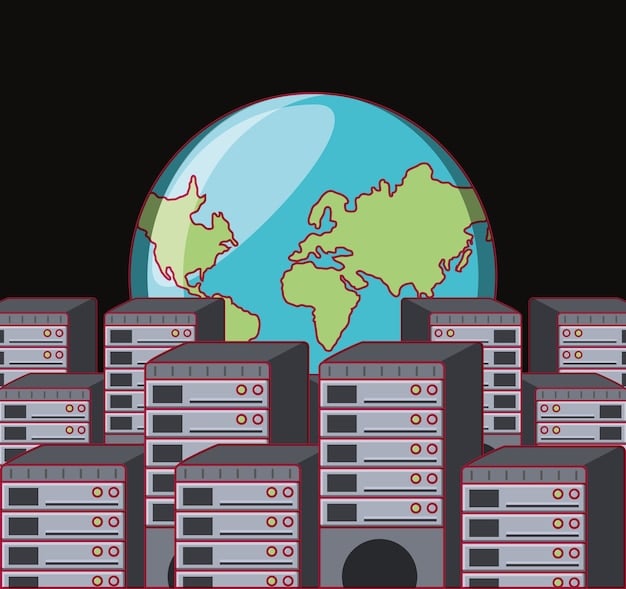Optimizing Cloud Performance: Insider Tips for US-Based Applications

Optimizing cloud performance for US-based applications involves strategic planning, continuous monitoring, and proactive adjustments to infrastructure and configurations to ensure reliability, speed, and cost-effectiveness.
Cloud computing has become a cornerstone for businesses across the United States, offering scalability, flexibility, and cost-efficiency. However, simply migrating to the cloud doesn’t guarantee optimal performance. This article delves into essential insider tips for optimizing cloud performance for US-based applications, ensuring they operate smoothly and efficiently.
Understanding Cloud Performance Challenges in the US
Operating cloud applications in the US market comes with unique challenges. These challenges range from latency issues due to geographical distances to regulatory compliance and data sovereignty requirements. Understanding these hurdles is the first step towards effective optimization.
Geographical Latency
The vastness of the United States can lead to significant latency issues. Data centers located far from users experience delays, impacting application responsiveness. Choosing the right cloud region is crucial.
Compliance and Regulations
US businesses must adhere to various compliance standards, such as HIPAA for healthcare and PCI DSS for financial services. Cloud configurations must align with these regulations to avoid legal and financial repercussions.

Optimizing cloud performance involves addressing these challenges head-on. Here are key strategies to consider:
- Select cloud regions closest to your primary user base to minimize latency.
- Implement robust security measures and compliance protocols tailored to US regulations.
- Regularly monitor network performance to identify and address bottlenecks.
Effectively managing these challenges ensures that cloud applications deliver optimal performance and value within the US market.
Right-Sizing Your Cloud Resources
One of the most common mistakes is over-provisioning resources, which leads to unnecessary costs. Right-sizing involves accurately assessing your application’s needs and allocating the appropriate amount of CPU, memory, and storage. This ensures you’re not paying for resources you don’t need.
Monitoring Resource Utilization
Regularly monitor your cloud resources to understand how they are being used. Tools provided by cloud providers offer detailed insights into CPU usage, memory consumption, and disk I/O.
Scaling Dynamically
Implement auto-scaling to dynamically adjust resources based on demand. Auto-scaling ensures your application can handle peak loads without manual intervention, and scales down during off-peak hours to save costs.
Right-sizing isn’t a one-time task; it requires continuous monitoring and adjustment. Consider using these practices:
- Conduct regular performance testing under various load conditions.
- Analyze historical data to predict future resource needs.
- Implement alerts to notify you of resource bottlenecks.
By accurately sizing your cloud resources, you can significantly reduce costs and improve performance.
Optimizing Network Configuration
Network configuration plays a crucial role in cloud performance. Poorly configured networks can introduce latency and bottlenecks. Optimizing your network involves selecting the right network topology, configuring DNS settings, and implementing caching strategies.
Content Delivery Networks (CDNs)
CDNs distribute your content across multiple servers globally, ensuring users receive content from the server closest to them. This significantly reduces latency and improves application responsiveness.
DNS Optimization
Optimize your DNS settings to ensure fast and reliable resolution. Use a reputable DNS provider and configure DNS caching to minimize lookup times.

Here are additional strategies for optimizing your network:
- Use private networks or VPNs to secure communication between different cloud resources.
- Implement load balancing to distribute traffic evenly across multiple servers.
- Configure firewalls and security groups to protect your network from unauthorized access.
A well-optimized network ensures that data flows efficiently, leading to improved application performance and user experience.
Leveraging Caching Strategies
Caching is a powerful technique for improving cloud performance. By storing frequently accessed data in a cache, you can significantly reduce the load on your backend servers and improve response times. Implement caching at various levels, including application-level caching, database caching, and CDN caching.
Application-Level Caching
Use in-memory caching solutions like Redis or Memcached to store frequently accessed data within your application. This reduces the number of database queries and improves response times.
Database Caching
Configure your database to use caching mechanisms to store frequently accessed query results. This reduces the load on the database server and improves query performance.
Caching strategies should be tailored to your specific application needs. Here are some best practices:
- Identify the data that is accessed most frequently and cache it.
- Set appropriate cache expiration times to ensure data freshness.
- Monitor cache hit rates to identify areas for improvement.
Effective caching can dramatically improve the performance of cloud applications by minimizing the need to fetch data from slower sources.
Securing Your Cloud Environment
Security is paramount in cloud computing. A compromised cloud environment can lead to data breaches, financial losses, and reputational damage. Implementing robust security measures is essential for protecting your applications and data.
Identity and Access Management (IAM)
Implement strong IAM policies to control who has access to your cloud resources. Use multi-factor authentication (MFA) to add an extra layer of security.
Data Encryption
Encrypt sensitive data at rest and in transit to protect it from unauthorized access. Use encryption keys managed by a reputable key management service.
Securing your cloud environment requires a multi-faceted approach. Consider these additional measures:
- Conduct regular security audits and penetration testing.
- Implement intrusion detection and prevention systems.
- Keep your operating systems and software up to date with the latest security patches.
A secure cloud environment not only protects your data but also ensures the reliability and availability of your applications.
Monitoring and Continuous Improvement
Cloud performance optimization is an ongoing process. Continuous monitoring and analysis are essential for identifying and addressing performance bottlenecks. Implement robust monitoring tools to track key metrics and proactively address issues before they impact users.
Key Performance Indicators (KPIs)
Define KPIs that are relevant to your application and business goals. These KPIs might include response time, error rate, and resource utilization.
Automated Monitoring Tools
Use automated monitoring tools to track KPIs and generate alerts when thresholds are exceeded. Tools like Prometheus, Grafana, and cloud provider monitoring services provide detailed insights into your application’s performance.
Continuous improvement requires a cycle of monitoring, analysis, and optimization:
- Regularly review your monitoring data to identify trends and anomalies.
- Conduct root cause analysis to understand the underlying issues.
- Implement changes to address the issues and monitor their impact.
By continuously monitoring and improving your cloud environment, you can ensure that your applications consistently deliver optimal performance.
Cost Optimization Strategies
While cloud computing offers cost benefits, uncontrolled spending can lead to budget overruns. Implementing cost optimization strategies is crucial for maximizing the value of your cloud investment. These strategies include resource scheduling, reserved instances, and cost allocation.
Resource Scheduling
Schedule resources to be turned off during off-peak hours to reduce costs. Use automation tools to manage resource scheduling.
Reserved Instances
Purchase reserved instances for predictable workloads to save money compared to on-demand pricing. Reserved instances offer significant discounts for long-term commitments.
Cost optimization should be integrated into your cloud strategy. Here are some additional tips:
- Use cost allocation tags to track spending by department or project.
- Regularly review your cloud bills to identify areas for cost savings.
- Optimize storage costs by using tiered storage options.
By implementing these cost optimization strategies, you can ensure that your cloud investment delivers maximum value.
| Key Point | Brief Description |
|---|---|
| 📍 Location Choice | Select US regions closest to users to cut latency. |
| 🔒 Security | Use IAM and encryption to safeguard data in the cloud. |
| 💰 Cost Control | Right-size resources and reserve instances to lower expenses. |
| 🚀 Caching | Implement caching to improve loading times. |
Frequently Asked Questions
▼
Optimizing cloud performance enhances application speed, cuts latency, ensures regulatory compliance, boosts user experience, and reduces operational costs, leading to overall business efficiency.
▼
Choosing the closest cloud region to your primary user base minimizes latency. This choice is crucial, markedly improving application performance and responsiveness for US-based users.
▼
A CDN distributes content across multiple servers, reducing latency and improving load times. CDNs ensure users receive content from the nearest server, therefore enhancing the overall experience.
▼
Security ensures data protection, reliability, and availability. Using IAM and encryption can reduce security risks, prevent downtime, and uphold trust with your users and stakeholders.
▼
Right-sizing involves accurately assessing resource needs. This practice prevents over-provisioning, cuts unnecessary expenses, and boosts performance by ensuring resources match actual application demands, optimizing budget use.
Conclusion
Optimizing cloud performance for US-based applications is a multifaceted endeavor that requires a deep understanding of the challenges and opportunities presented by the cloud. By implementing the strategies outlined in this article, businesses can ensure their applications operate efficiently, securely, and cost-effectively, providing a competitive edge in the dynamic US market.





